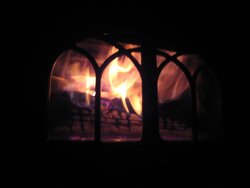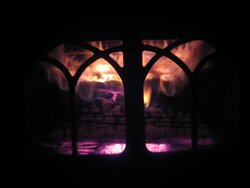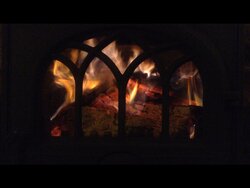I want to ask if people have discovered that different techniques are needed to burn loads that solely consist of particularly hard woods, such as oak?
I thought I was having a steep curve learning how to reuse my stove since it got fixed recently and was now behaving very differently ( presumably as it should behave!). It seemed to me that learning curve had been complicated by the fact I was exploring different ways of handling burn cycles. Now I have come to realise that there is a another factor in my learning curve... Which might make it look even more complex, except for the fact that I think it may turn out to be that this one thing has been causing the issue all along... The issue being that I seem recently to be rarely able to get any secondary burns from my current wood (which is well under 20% moisture and not huge splits.. But it IS all oak)...
So now I am wondering if the stove is not the issue, but rather the dense wood I am burning and am not used to. I've been burning hardwoods all along, but usually a mix of ash, birch and a little oak. I realised today (duh) that my wood I'm using right now, exactly since the changes in burn behaviour ( and coincidentally also exactly since my stove was fixed) is all oak. I've never burned only oak before. This is what I am discovering..
- I fill the stove up and the primary air is of course open.
- Normally, I would be able to turn the air down after around 15 mins and secondaries would arrive. The stove-top temp would be around 550-600 F by this point.
- Now however, with the oak, it's burning very differently. During the hot burn period, only the sides of the logs are flaming for ages. If I try to turn down after the usual amount of time the flames die right back and the logs smoulder. I have to open up the air again.
I have tried all manner of permutations with regard to when I begin to shut down the air ( remember, until today, I thought the issue was my stove) but it seems that all I can do is keep the air almost completely open or the flames die back and no secondaries.
This situation can last for almost two hours, during which time the stove top temp never exceeds 600 and is mostly closer to 550. It's as if the stove is struggling to be able to work hard enough to make an impression on this wood.
After almost two hours the wood finally starts to flame on the upper surfaces as well as the sides and there may be secondaries around then if I turn the air down by about 1/4 - no more, or the logs smoulder again... And the secondaries last only a few minutes before they die away.
So at this point in time, after almost two hours of flaming hard, so as I don't get smoke from my flue, the logs are now down to just red coals. They still have form, but won't for much longer... In effect this means my logs are burning quicker because of the high air flow (understandable) but cannot be burned more slowly or they smoulder without secondaries?!
Can anyone out there advise me if burning only oak really should be such a different experience and if oak is normally so reluctant to release it's gases? Am I missing something? I do recall hearing some say once, of a load of oak, "I can't get this stuff to burn"...
I feel like I'm sounding a bit crazy here.. But this really has been my experience the last few days.
I thought I was having a steep curve learning how to reuse my stove since it got fixed recently and was now behaving very differently ( presumably as it should behave!). It seemed to me that learning curve had been complicated by the fact I was exploring different ways of handling burn cycles. Now I have come to realise that there is a another factor in my learning curve... Which might make it look even more complex, except for the fact that I think it may turn out to be that this one thing has been causing the issue all along... The issue being that I seem recently to be rarely able to get any secondary burns from my current wood (which is well under 20% moisture and not huge splits.. But it IS all oak)...
So now I am wondering if the stove is not the issue, but rather the dense wood I am burning and am not used to. I've been burning hardwoods all along, but usually a mix of ash, birch and a little oak. I realised today (duh) that my wood I'm using right now, exactly since the changes in burn behaviour ( and coincidentally also exactly since my stove was fixed) is all oak. I've never burned only oak before. This is what I am discovering..
- I fill the stove up and the primary air is of course open.
- Normally, I would be able to turn the air down after around 15 mins and secondaries would arrive. The stove-top temp would be around 550-600 F by this point.
- Now however, with the oak, it's burning very differently. During the hot burn period, only the sides of the logs are flaming for ages. If I try to turn down after the usual amount of time the flames die right back and the logs smoulder. I have to open up the air again.
I have tried all manner of permutations with regard to when I begin to shut down the air ( remember, until today, I thought the issue was my stove) but it seems that all I can do is keep the air almost completely open or the flames die back and no secondaries.
This situation can last for almost two hours, during which time the stove top temp never exceeds 600 and is mostly closer to 550. It's as if the stove is struggling to be able to work hard enough to make an impression on this wood.
After almost two hours the wood finally starts to flame on the upper surfaces as well as the sides and there may be secondaries around then if I turn the air down by about 1/4 - no more, or the logs smoulder again... And the secondaries last only a few minutes before they die away.
So at this point in time, after almost two hours of flaming hard, so as I don't get smoke from my flue, the logs are now down to just red coals. They still have form, but won't for much longer... In effect this means my logs are burning quicker because of the high air flow (understandable) but cannot be burned more slowly or they smoulder without secondaries?!
Can anyone out there advise me if burning only oak really should be such a different experience and if oak is normally so reluctant to release it's gases? Am I missing something? I do recall hearing some say once, of a load of oak, "I can't get this stuff to burn"...
I feel like I'm sounding a bit crazy here.. But this really has been my experience the last few days.
Last edited:




 even though it is quite a task to top-down light in such a small firebox! But the side-only log flaming was happening at all loads - and there is sometimes 1-2 inches gap between splits and tubes
even though it is quite a task to top-down light in such a small firebox! But the side-only log flaming was happening at all loads - and there is sometimes 1-2 inches gap between splits and tubes


